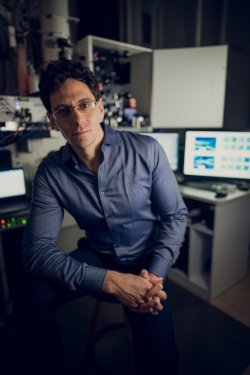Recognized for: Creative ways of generating light, X-rays, and other types of radiation from the interaction of electrons with novel materials. His work combines rigorous theoretical predictions and pivotal proof-of-concept experiments, and opens the possibility for miniaturized radiation sources for both fundamental research and practical applications such as medical imaging and security scanners.
Ido Kaminer
Areas of Research Interest and Expertise: Light-matter interactions, Electron Microscopy, Quantum Electrodynamics, Photonics, Cherenkov Effect
Previous Positions:
BSc, Technion – Israel Institute of Technology
PhD, Technion – Israel Institute of Technology
Postdoctoral Fellow, Massachusetts Institute of Technology, USA
Research Summary:
Ido Kaminer, PhD, has discovered several novel phenomena that demonstrate how light and matter interact in unusual physical settings. He has not only formulated the quantum theories that predict these phenomena, but also designed state-of-the-art experiments that prove their existence. His discoveries have transformed our understanding of the physical foundation of light-matter interaction, and hold enormous potential for real world applications.
One focus of Kaminer’s research is to develop a miniaturized, low-cost, and tunable X-ray source, which has been a long-standing challenge in physics and engineering. He showed that light and X-rays can be generated by shooting high-speed free electrons onto the surfaces of two-dimensional (2D) materials and nano-materials. He even managed to adjust the spectrum of the output X-ray by controlling the composition of the 2D materials being hit by the free electrons. This was the first time that a highly tunable X-ray source has become possible without using expensive, kilometer-long facilities. This discovery may find a wide range of applications in biomedical imaging and security scanning.
Kaminer is also known for revitalizing research interest in the Cherenkov Effect, and utilizing it to efficiently detect high energy particles. First observed in 1934 and recognized with a Nobel Prize in 1958, the Cherenkov Effect occurs when charged particles (such as electrons) travel through a gas, liquid, or solid medium at very high speeds, giving rise to a brief flash of light. For over 80 years, it had been widely believed that everything about it was fully understood. Very recently, however, Kaminer revealed how the quantum nature of the charged particles could alter the photons emitted by the Cherenkov Effect. His work greatly improves the capability of using this effect to track high energy particles, and has led him to initiate a collaboration with CERN to design next-generation particle detectors inside the world’s largest, most powerful particle accelerator.
“I am grateful for the honor and would like to thank my mentors and my students for sharing their passion for science with me. My research strives to understand the roots of quantum mechanics, which forms the foundations of our physical reality. This journey takes us through surprising discoveries and sometimes leads us to exciting new applications. I wake up every morning knowing that the most exciting discoveries are still ahead, and looking forward to sharing this science-journey with colleagues and students for many more years.”
Key Publications:
R. Dahan, S. Nehemia, M. Shentcis, et al., I. Kaminer. Resonant Phase-matching Between a Light Wave and a Free Electron Wavefunction. Nature Physics, 2020.
K. Wang, R. Dahan, M. Shentcis, Y. Kauffmann, A.B. Hayun, O. Reinhardt, S. Tsesses, I. Kaminer. Coherent Interaction between Free Electrons and a Photonic Cavity. Nature, 2020.
Y. Kurman, I. Kaminer. Tunable Bandgap Renormalization by Nonlocal Ultra-strong Coupling in Nanophotonics. Nature Physics, 2020.
Y. Kurman, N. Rivera, T. Christensen, S. Tsesses, M. Orenstein, M. Soljačić, J.D. Joannopoulos, I. Kaminer. Control of Semiconductor Emitter Frequency by Increasing Polariton Momenta. Nature Photonics, 2018.
Other Honors:
| 2020 | The Marker’s list of 40 under 40 |
| 2019 | ERC Starting Grant, European Research Council (ERC) |
| 2017 | Azrieli Faculty Fellow, The Azrieli Foundation |
| 2014 | Marie Curie International Outgoing Fellowship for Career Development, European Union |
| 2014 | APS Award for Outstanding Doctoral Dissertation in Laser Science, American Physical Society (APS) |
| 2012 | The IPS Prize for a Graduate Student in Theoretical Physics, Israel Physical Society (IPS) |
| 2007 | The Knesset Award for Outstanding Undergraduate Achievements, The Knesset (Israeli Parliament) |
In the Media:
Phys.org – The First Demonstration of Phase-matching between An Electron Wave and A Light Wave
The Jerusalem Post – Technion Researchers Develop New Radiation Sources
The Times of Israel – Groundbreaking Israeli Microscope Can Change the Face of Tech — Scientists
The Jewish Press – Technion Researchers Create Unique Quantum Microscope That Records Flow of Light
ISRAEL21c – Ultraviolet Light Can Reduce Covid Transmission Indoors
The Jerusalem Post – Israel’s new quantum microscope will improve cell phone screen sharpness
phys.org – Tunable free-electron X-ray radiation from van der Waals materials
Futurism – New microscope is so powerful it can watch light move
Physics Today – Nanostructures enhance the efficiency of a scintillator
phys.org – One-of-a-kind microscope enables breakthrough in quantum science
Physics World – Electrons passing over nanophotonic materials could create synchrotron-like light
MIT News – A new way to make X-rays
phys.org – Ramanujan machine automatically generates conjectures for fundamental constants
New Scientist – Computer attempts to replicate the dream-like maths of Ramanujan
The Times of Israel – For $1 per person, UV light can help protect world from virus, scientists claim
The Jerusalem Post – Scientists support use of ultraviolet light to prevent COVID-19 spread
Forbes – Light Kills Coronavirus. Here’s How It Could Help Beat Covid-19
Science Daily – Scientists support the use of ultraviolet light to reduce SARS-CoV-2 transmission indoors
phys.org – Researchers discover new way to turn electricity into light using graphene
MIT News – Particles accelerate without a push
Globes – Israeli breakthrough research in 2020 [Hebrew]
Haaretz – Research at the Technion contradicted the prediction of the greatest Soviet physicist [Hebrew]
phys.org – Physicists turn to Maxwell’s equations for self-bending light
New Scientist – Self-bending light boomerangs could help surgeons
Website
